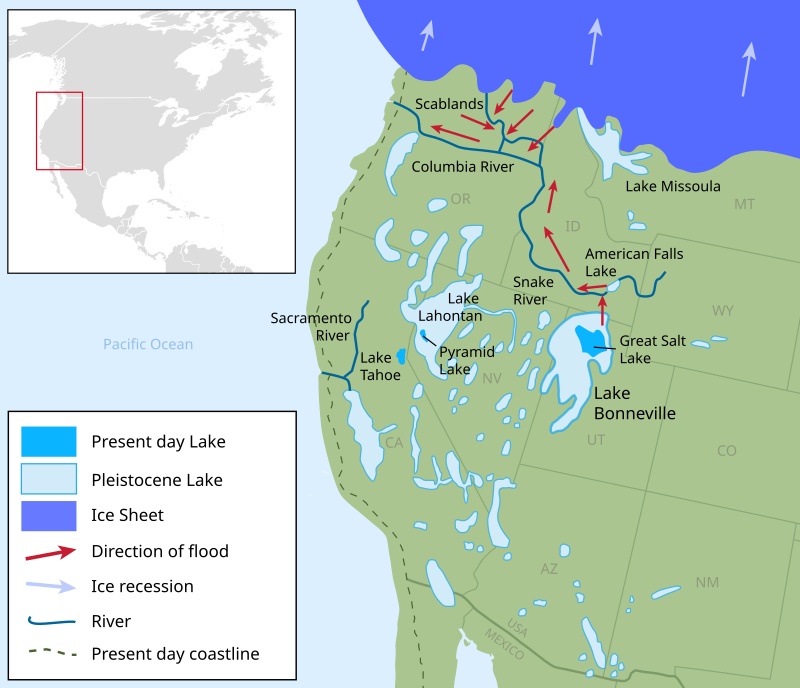I’ve mentioned before my fondness for learning random new things. This has morphed from grabbing random volumes of the Encyclopedia when I was a kid to the modern-day equivalent, which is either looking at Quora or punching up topics on Wikipedia that crossed my mind.
I was flying over the Great Salt Lake a few days ago, and I decided to learn about it (my initial curiosity was regarding whether there was life in the lake or not, and there is, although mostly in the form of brine shrimp). One illustration was particularly striking to me: it showed how the present-day Salt Lake (which is huge) used to be just a small portion of a vastly larger body of water called Lake Bonneville. (You have probably heard of the fabled Bonneville salt flats where land-speed records are challenged).

As you can see from the map, following the Ice Age, the Western United States had so many lakes that it resembled Canada. Nevada, which is bone-dry in the present day, had a meaningful portion of its land underwater, and the entire central valley of modern-day California was a sea. How magical it would be to teleport to that time period and survey the landscape, which, in geological terms, was just a few moments ago!
A metaphor dawned on me a few days later, and it was related to crypto. Specifically, the new Cryptonaissance product from Molecool and Scott. (If you haven’t checked out Slope’s page about this product, please do so, because all four of the videos are there).
A point that Mole made in one of the videos which never occurred to me is this: the money flowing into crypto pretty much is going one direction. The reason is simple: it’s an enormous pain in the ass to make it flow the other direction.
For instance, if I sell some stock from my Merrill Lynch account, I can transfer cash from that brokerage account to my checking account in literally a fraction of a second. Even if you take into account any kind of settlement period from a trade, you’re talking about, what, waiting a single day? It is effortless to change cash into stock and back into cash again.
With crypto, there are a whole series of steps you have to go through to change, for example, a Cardano coin into green cash that you can spend at Whole Foods. It takes effort, it takes time, and generally speaking, it’s a big pain in the butt. So people don’t deposit money into crypto accounts with the idea of hopping between spendable fiat and crypto. The money goes in there and does the only easy thing it is capable of doing, which is being converted from one coin to another. It’s the Roach Motel of cash.
So the metaphor that leaped to mind was that Lake Bonneville was basically the $6 trillion that the Fed created out of thin air and that which remains now – – that is to say, the much smaller Great Salt Lake – – is the $2 trillion of various cryptocurrencies out there. The rest of the water has retreated elsewhere for other more traditional purposes (home-buying, cars, groceries, gas, vacations, and what-have-you). But there is an isolated body of water, surrounded by hostile desert, which isn’t going anywhere. It is an island made of water, so to speak, conjured up out of the largesse of the Fed, and otherwise, it simply would not exist.
There’s another twist to this metaphor, however. As I envision the Crypto Sea, as it were, it looks something like this:

That is, a whole bunch of lakes – – hundreds of them. One of them huge (Lake Bitcoin). Some quite larger, although smaller (Lake Ethereum, Lake Cardano, Lake Litecoin, etc.) And on and on, down to the tiny little puddles that no one has ever heard of.
And there are people scurrying around, pitchers in hand, ready to scoop water out of one lake and into another. Some people don’t bother and simply leave the water where it is. Some people move water actively. But the size of each Lake changes constantly, either larger or smaller, and sometimes the entire region gets the benefit of more water (through a huge rainstorm of fresh fiat) or the detriment of shrinking lakes (through a scorching hot day, such as the instances where, as a whole, the crypto market gets really unpopular).
But the point is that, collectively, this entire ecosystem is fixed and siloed off from the rest of the world. The trick to it all – – and my impression is that this is what Cryptonaissance is all about – – is figure out which lakes get ladled larger and which ones get diminished. It’s an aquatic game of musical chairs, and this absurd pastime would have never been possible if Jerome Powell hadn’t opened the heavens up and dumped a diluvial cataclysm on top of all of us.
But since it’s here, let’s see if we can do something with it.

